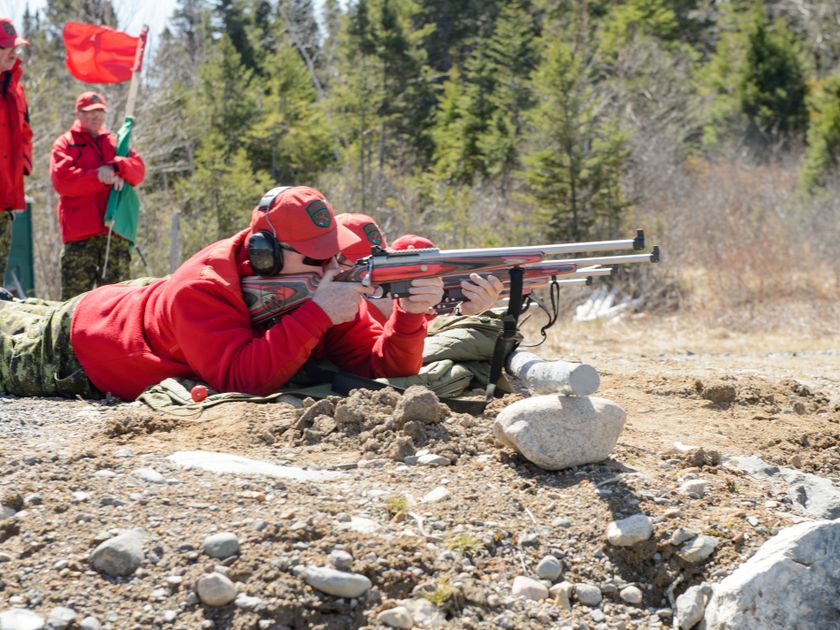Watchers of the North, Canadian Rangers
"The more complicated a rifle gets ... the more prone you are to problems with parts breaking or jamming in a harsh environment."
"It might seem old-fashioned ... [but] the retention of the Lee-Enfield by the Canadian Rangers was a wise choice for their role and environment."
Eric Fernberg, arms collection specialist, Canadian War Museum
 |
| Canadian Ranger Ernestine Karlik armed with a Lee-Enfield in 2014. |
At that time anyone was welcome to commit to joining the PCMR; loggers, trappers, prospectors, ranchers, while most of the group was comprised of Aboriginals, the people who lived in the North and in whose interests just as much as the government's and the military, it was to protect their native land. Teens to retirees, all were accepted in the ranks, given rudimentary training and a Lee-Enfield rifle. Those who couldn't be reached for training were given an instruction manual full of useful information.
The Rangers were reorganized into five Canadian Ranger Patrol Groups (CRPGs) reflecting the geographic makeup of Canada in 1998:
CRPG One in Northern Canada. totalling 58 patrols in the Yukon, Northwest Territories, Nunavut, Alberta, Saskatchewan, northern British Columbia and northern Manitoba;
CRPG Two in Quebec, with 19 patrols;
CRPG Three in Northern Ontario, with 9 patrols;
CRPG Four in the Pacific west coast and interior of British Columbia, with 27 patrols; and
CRPG Five in Newfoundland and Labrador, with 28 patrols.
Their assigned tasks include the provision of a military presence in support of sovereignty inclusive of reporting unusual activities; collecting local data of significance in support of military operations;
conducting surveillance/sovereignty patrols and additionally assisting Canadian Forces activities by
providing local expertise, guidance and advice; conducting Northern Warning System patrols; providing local assistance to Search and Rescue activities.
Examples of Ranger activities include reporting unidentified vessels within Canadian waters off the northeast coast of Quebec; participating as observers/guides on the west coast to counter illegal immigration; and responding to disaster situations such as aircraft crashes in the far north.
The rangers have been equipped with Lee-Enfield rifles since their inception, a weapon ubiquitous and reliable, used by British forces and their allies for the past 114 years. The rifle is viewed by some as antiquated, and criticism has abounded that the Rangers remain equipped with a rifle that is seen as inadequate, and an insult to the importance to Canada of the Rangers themselves. The truth of the matter is, the reason the Lee-Enfield has been used for so long lies in its exceptional design and qualities.
It gained its fame for the powerful .303 cartridge known for its deadly results with one shot; as useful in stopping an enemy combatant as it was in stopping a charging polar bear. Its stock made of wood is resistant to cracking or splitting in the extreme cold temperatures in which the weapon is used. As a bolt-action device the Lee-Enfield has few moving parts to cause mechanical problems, even while every shot must be pushed manually into place by the shooter, leading to slower firing.
"It has been used in every conceivable theatre of war ... and its high build quality and tough construction made it all but indestructible."A well-trained handler could fire and reload quickly enough to squeeze off 30 rounds per minute, despite that it cannot shoot as fast as modern automatic rifles. An early version of the Lee-Enfield was shipped to Canada for military use in 1896. The later, short-muzzled Lee-Enfield was manufactured in 1904. During the First World War, Canadians joined battle with the Canadian-made Ross Rifle, a weapon so prone to malfunction Canadians took to scavenging Lee-Enfields from dead British soldiers.
Historian Martin Pegler
The Lee-Enfield thereafter remained the weapon of choice for Canadian soldiers until the 1950s. In the English-speaking world the Lee-Enfield was the equivalent of the Soviet-made AK-47. Turning up after the Second World War in surplus markets the rifles soon made their appearance in conflicts, skirmishes and civil wars around the world. They were sent by the U.S. in the 1980s to Mujahedeen fighters in Afghanistan against the Soviet Union. Now they can be seen in the hands of Taliban fighters as a sniper rifle.
Several police forces in the developing world maintain them in their arsenals. In Canada, the Lee-Enfield was the choice of hunters. "A lot of us grew up using the old .303s ... it was a good gun, it was a gun you could depend on", noted Northwest Territories MP Michael McLeod. This week the Canadian Rangers have been given replacements of their Lee-Enfields with the specially commissioned Colt Canada C19; bolt-action, wood stock, firing ten shots. Lighter, more accurate, with several cold weather modifications; a larger trigger guard to accommodate gloved hands.
The Lee-Enfield can be bought today at prices between $700 and $900, still sought-after as an excellent hunting rifle, its price comparable to that of a brand-new higher-end bolt-action rifle. About ten thousand of the rifles are intended by the Department of National Defence to be turned over to cadets for target practice, while another five thousand will be given as gifts to Rangers with valid gun licenses.
 |
|
Canadian ArmyVerified account @CanadianArmy
The .308 calibre C19 replaces the Lee-Enfield .303 rifle which the Canadian Rangers have used since 1947. The C19 is lighter, shorter, more precise, and more reliable in below-freezing temperatures
|
Labels: Canada, Northern Defence, Rangers
0 Comments:
Post a Comment
<< Home